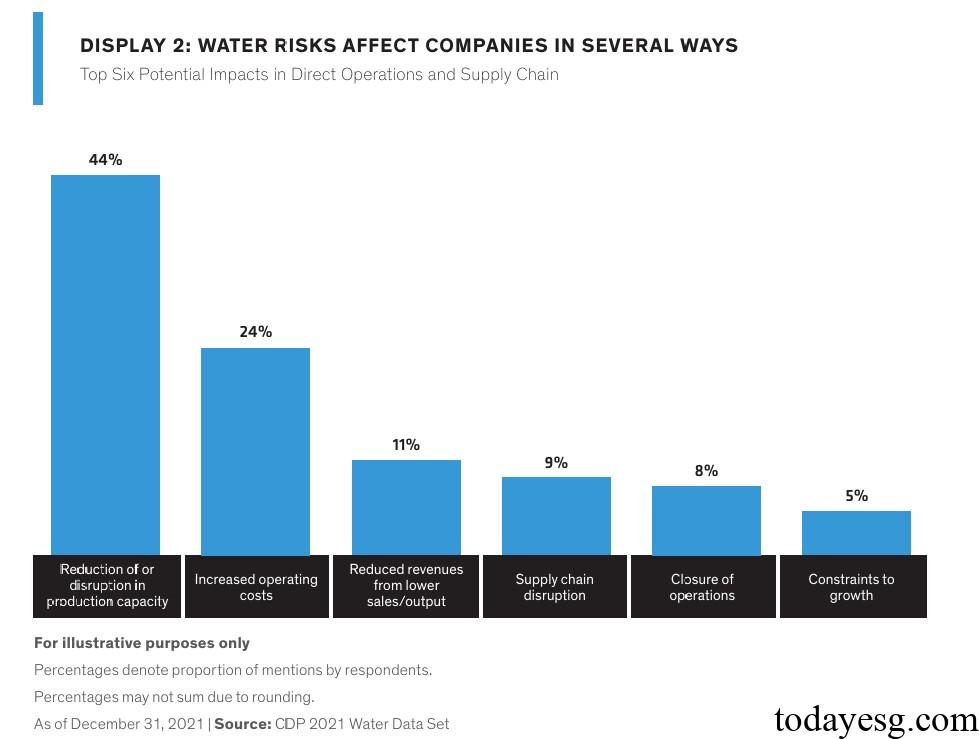Sustainable Water Resource Management Investor Guide
Alliance Bernstein releases an investor guide for sustainable water resource management, aimed at introducing how to manage water resource risks to achieve sustainable portfolio development.
Alliance Bernstein believes that traditional water resource management mainly relies on information disclosure, and investors should consider improving the water resource management capabilities of investees through active engagement and other means.
Related Post: CDP Releases Global Water Report
Background of Sustainable Water Resource Management
Water resources are closely related to food security, economic development, and public health. The United Nations predicts that global freshwater supply will be 40% short by 2030. The World Resources Institute believes that 25% of countries worldwide face severe water resource pressures every year, which can have a material impact on investors. CDP believes that water resource risks will affect 69% of listed companies’ businesses, with potential value losses of up to $225 billion. These impacts include a decrease in production capacity (44%), an increase in operating costs (24%), supply chain disruptions (9%), and business closures (8%).

Alliance Bernstein believes that water resource risk has an impact on a company’s cash flow and earnings, so investors who pursue long-term returns need to carefully consider how to reduce the water resource risk of their investment portfolio. Sustainable water resource management is an important measure among them. There are two main ways of sustainable water resource management: data disclosure and stakeholder management. Data disclosure can improve information transparency, and stakeholder management can drive water resource management from multiple dimensions.
Despite the increasing requirements and standards for water resources data disclosure, this method has the following pitfalls:
- Lack of consistency in water resource targets: Water resource targets are different from temperature targets (such as 1.5 degrees Celsius) and carbon emission targets (such as net zero by 2050), and there is lack of consistency measurement standards.
- Impact of water resources varies: Carbon emissions have a similar impact globally, while differences in the location, type, and use of water resources can lead to changes in their impact.
- Insufficient water resource data: Water resource management and accounting methods are still in the early stages, and internal and external data may be difficult to accurately measure the company’s water resource management capabilities.
- Neglect social factors: Quantitative analysis of water resources cannot incorporate social factors, and the stakeholders involved in water resources and their cooperation are crucial in water resource management.
Sustainable Water Resources Management Framework
Based on the above analysis, Alliance Bernstein has created a sustainable water resource management framework to provide guidance for investors to evaluate the company’s water resource risk management and mitigate water resource risks. The sustainable water resources management framework is divided into five parts:
- Recognition: Recognize the application background of water resources is a prerequisite for stakeholder management. Companies need to develop clear support policies and codes of conduct, and the board of directors and senior management need to focus on how to reduce water resource risks.
- Accountability and Oversight: Companies need to clarify and allocate water resource regulatory responsibilities, establish mechanisms for evaluating, recording, and reporting water resource management, and incorporate water resource management into their business activities and supply chains.
- Resourcing: Companies need to support the implementation of water resource management projects, such as implementing water resource management methods and cultivating the risk management capabilities of relevant personnel.
- Stakeholder Mapping: Companies need to identify and assess environmental and social risks associated with water resources and consider their impact on stakeholder groups.
- Stakeholder Engagement: Companies can collaborate with stakeholders to continuously assess and manage water resource risks and improve operational efficiency.
Reference:
Water Risks an Investor’s Guide to Navigating Sustainable Water Management
ESG Advertisements Contact:todayesg@gmail.com








